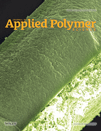Characterization of shear stress at the tool-part interface during autoclave processing of prepreg composites
Abstract
In this article, shear stress between an aluminum tool and a carbon fiber-epoxy prepreg is characterized during cure using polymeric release agent and release film at the tool-part interface. The effects of surface roughness, release materials, pull-out speed, temperature, and normal force (autoclave pressure) on the shear stress are investigated using a customized friction rig. Results show that the interfacial shear stress decreases as the temperature increases and it increases as the normal force increases when using either the release film or the release agent. Additionally, changes in surface roughness from 1.35 to 0.18 μm decrease the shear stress 10–27% while the use of release agent shows a decrease between 23% and 51% in the shear stress. Furthermore, strong adhesion between the tool and the part is observed when using release agent and pull-out speeds of 0.05 mm/min (static/dynamic friction ratio of 5.29 ± 0.19). Using the experimental data, a mathematical approach based on the Coulomb's friction model is proposed to predict the friction force at the tool-part interface. © 2013 Wiley Periodicals, Inc. J. Appl. Polym. Sci., 2013




